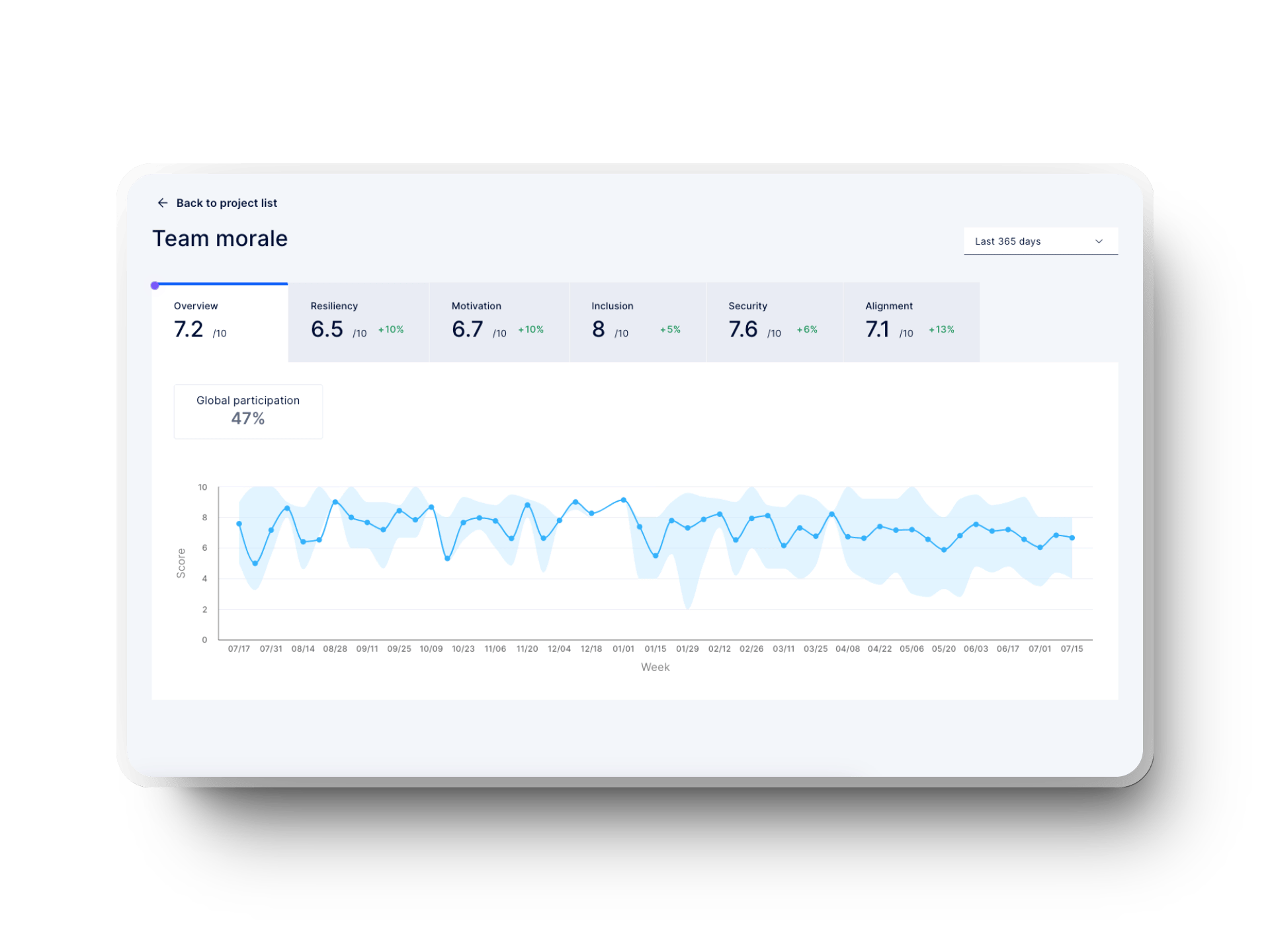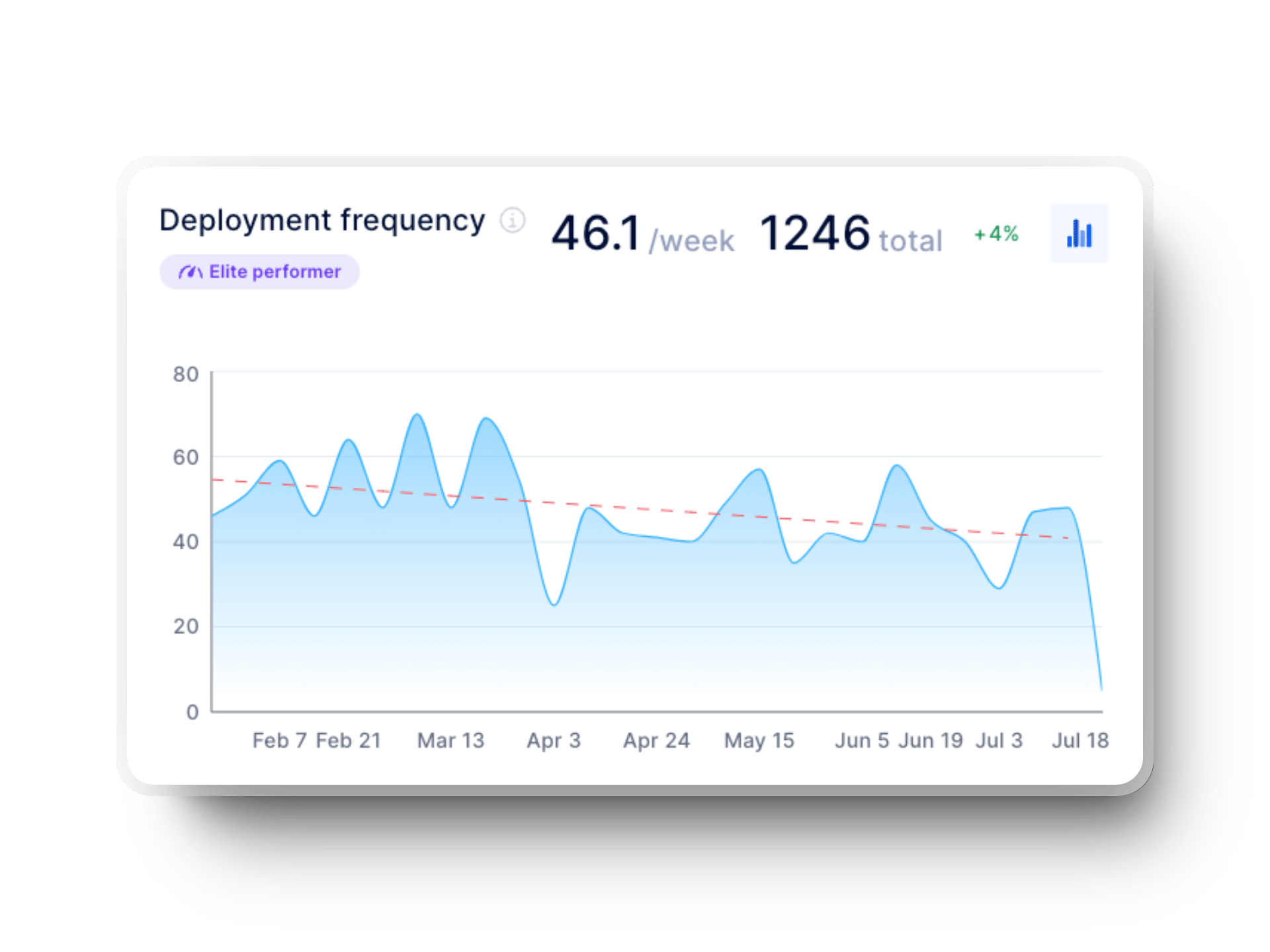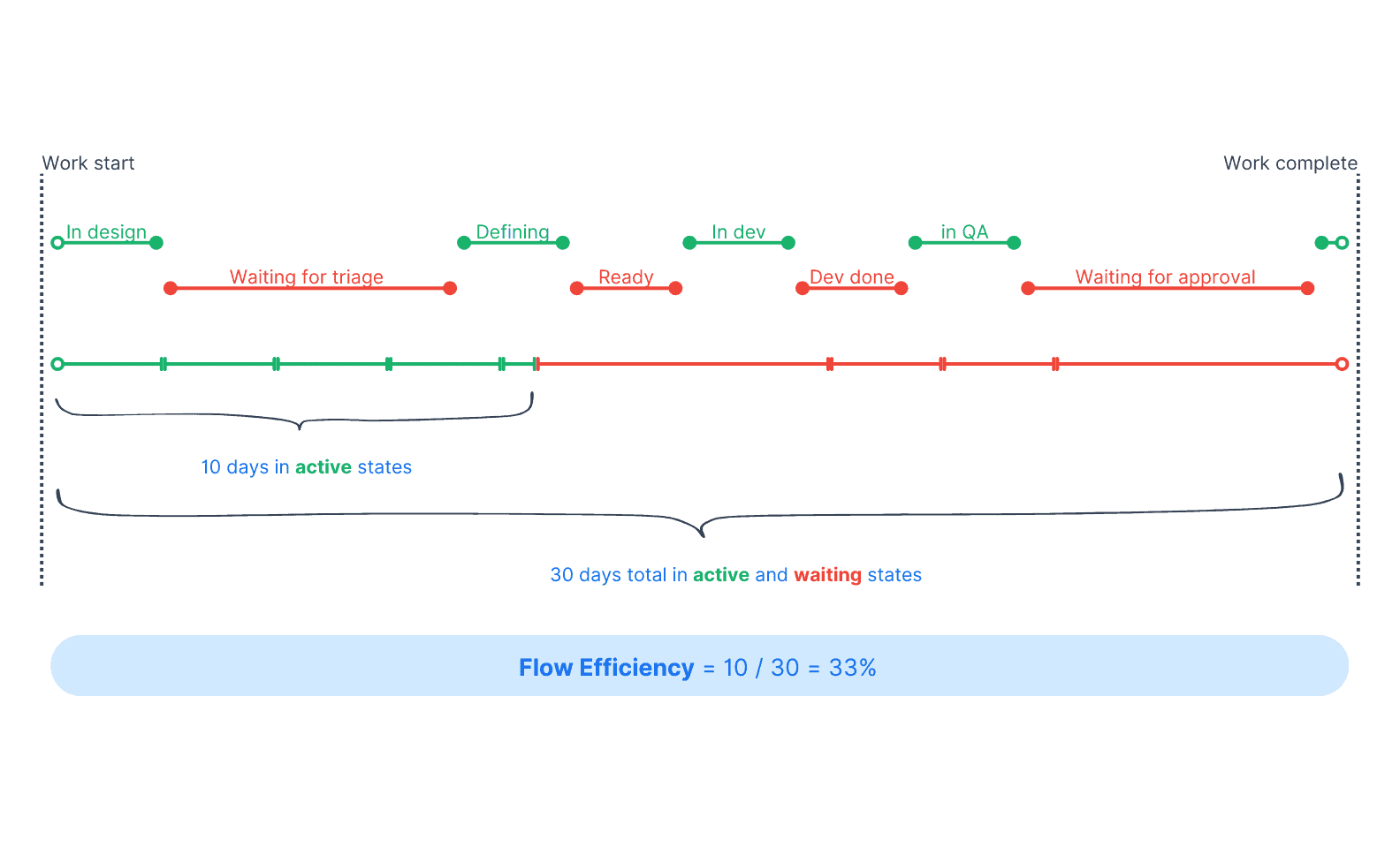Are your engineering teams constantly battling missed deadlines, endless bottlenecks, or wasted resources?
Then, they must be missing out on engineering efficiency, the ability to deliver high-quality, functional software with minimal wasted effort, time, and resources.
If you’re wondering how to measure and improve engineering efficiency effectively, this blog post is for you. We’ll break down key strategies, tools, and metrics to help your teams work smarter and achieve better results.
Let’s dive in!
What Is Engineering Efficiency?
Engineering efficiency is the capability of software development teams to create functional, high-quality products while minimizing wasted time and effort. It focuses on streamlining processes, reducing unnecessary steps, and maximizing productivity. This ensures that all your engineering efforts align with business goals and consistently deliver value.
Pro tip: Axify helps you track and optimize engineering efficiency through actionable insights and innovative features, including DORA metrics dashboard, software delivery forecasting and Value Stream Mapping.
Engineering Efficiency vs Effectiveness vs Productivity
To identify areas for improvement and balance priorities effectively, it’s essential for teams to understand the differences between engineering efficiency, effectiveness, and productivity:
- Efficiency: Focuses on doing tasks correctly with minimal waste. It’s about streamlining processes and reducing unnecessary steps to optimize resource usage.
Efficiency is about doing things right to minimize waste and maximize output.
- Yugank Aman, Data, AI, and Engineering Leader
- Effectiveness: Ensures that the right tasks are prioritized and executed to achieve meaningful and impactful outcomes that align with business and customer goals.
- Productivity: Measures the output generated relative to the input invested. It reflects how well resources like time, skills, and tools are used to maximize results.
Output vs Outcome in Engineering Efficiency
Outputs are tangible products or services resulting from an organization's activities, such as the number of features developed or tasks completed. Outcomes, on the other hand, represent the impact or changes that occur due to these outputs. They reflect the effectiveness of the work in achieving desired objectives.
And that’s why you should focus on outcomes rather than tracking outputs.
After all, the right outcome will benefit your company and your customers, while output doesn’t directly translate into value.
Why Engineering Efficiency Matters
Good engineering efficiency comes with a slew of benefits, including:
1. Faster Time-to-Market
Streamlined processes lead to quicker releases. That means your teams can gather customer feedback sooner and iterate rapidly. This approach supports a fail-fast, learn-fast methodology to maximize outcomes.
2. Improved Developer Productivity
Engineering efficiency helps eliminate distractions and bottlenecks. As a result, developers can focus on meaningful work and enhance productivity. You’ll need a good Value Stream Mapping (VSM) tool to have real-time visibility into the entire software development lifecycle (SDLC). That way, you can identify and fix bottlenecks and optimize workflows for speedier delivery.

3. Cost Reduction
Efficient processes minimize unnecessary rework, debugging, and resource wastage, which leads to cost savings. A good resource allocation tool can give insight into how team resources are distributed across tasks. When you optimize planning and load balancing, you become efficient and save costs.
![]()
4. Team Morale
Teams are more motivated when they work effectively and see tangible results. We advise using a solid Team Well-Being Tracker to monitor team morale. This kind of tool can assist you in promoting a healthy organizational culture and supporting sustained productivity.

How to Measure Engineering Efficiency
Measuring engineering efficiency involves many steps, such as tracking crucial metrics, using the right tools, and more. This guide explains it all in detail.
Engineering Efficiency KPIs to Track
Some crucial engineering efficiency metrics include:
1. Cycle Time
Cycle time measures the time it takes to complete a work item, from start to finish. This metric highlights how quickly teams can deliver features, resolve bugs, or implement changes. Shorter cycle times indicate improved operational efficiency and quicker time-to-market.

2. Deployment Frequency
This KPI tracks how often new code is deployed to production. Higher deployment frequency reflects efficient development processes and a healthy continuous integration/continuous deployment (CI/CD) pipeline.

This contributes to engineering efficiency by ensuring faster feedback loops, reducing time-to-market, and maintaining customer satisfaction through continuous value delivery.
3. Flow Efficiency
Flow efficiency measures the ratio of active work time to total lead time to shed light on process bottlenecks. Higher flow efficiency indicates streamlined workflows with minimal delays.

Flow efficiency directly impacts engineering efficiency by highlighting bottlenecks and delays in the workflow. Besides, optimizing flow efficiency results in faster delivery and more predictable outcomes.
4. Coding Time
Tracking coding time helps understand how much of a developer's day is spent on active coding versus other tasks like meetings or administrative work. This metric is valuable for identifying opportunities to improve the developer experience and increase productivity. At the same time, you can identify inefficiencies that detract from productivity.
Improving coding time (and coding quality) ensures engineers focus on value-adding activities, a key efficiency driver. We’d advise you to look into collaborative programming and shift left on QA.
5. Number of Code Commits
The frequency and volume of code commits offer insights into team productivity. While this metric should not be used in isolation, it provides context when paired with other KPIs, such as code quality and pull request merge times.
Optimizing code commits helps you maintain momentum and reduces the risk of large, error-prone changes. This contributes to an overall better engineering efficiency.
6. Pull Request Merge Time
This KPI measures the time it takes to review and merge pull requests. A shorter merge time suggests efficient collaboration and code review processes. Optimizing this metric will reduce delays in the development process, improving team velocity and project timelines.
-1.webp?width=851&height=281&name=pull%20requests%20cycle%20time%20breakdown%20graph%20in%20axify%20%20(1)-1.webp)
7. Velocity
Velocity reflects the amount of work completed during a sprint or iteration. It helps teams measure their progress against planned objectives and ensure alignment with organizational goals. Tracking this metric allows teams to refine their workflows, identify capacity issues, and consistently deliver features and fixes. All this supports your engineering efficiency.

8. Resource Allocation
Efficient resource allocation ensures that engineering efforts are focused on high-priority tasks, which avoids overallocation or bottlenecks. It also helps teams distribute workloads effectively, maintain consistent productivity, and maintain high morale, all essential for engineering efficiency.

Engineering Efficiency Tools
So, you’ve now seen the metrics to track and why they’re essential for engineering efficiency. Well, here are the best tools to follow these KPIs:
- Axify: Offers detailed insights into DORA and flow metrics. These engineering metrics allow teams to detect issues in cycle time, deployment frequency, PR merge time – and more. Fix them to improve the SDLC and achieve better outcomes.
- Jira/Linear: Tracks the progress of work items and provides details on backlog health so that teams can stay organized and aligned with their goals.
- Git Analytics Platforms (e.g., GitHub Insights): Monitors pull request reviews, code churn, and other engineering metrics to help teams enhance code quality and address technical debt.
Pro tip: Axify integrates seamlessly with these tools and offers a centralized view of essential metrics. This eliminates the need to switch between multiple platforms.
How NOT to Measure Engineering Efficiency
Let’s have a look at some things to avoid when measuring engineering efficiency:
- Focusing only on output metrics: Metrics like velocity or lines of code may look impressive, but they fail to capture critical factors such as code quality, business alignment, and customer satisfaction.
- Overloading teams with tools: Introducing too many project management tools can overwhelm engineering teams and lead to inefficiencies instead of streamlining the development lifecycle.
- Evaluating developers individually: When you measure the individual performance of developers, you can overlook the importance of team collaboration, shared engineering efforts, and alignment with broader team goals.
- Ignoring unique team contexts: Using uniform benchmarks across all the teams without considering unique project scope, challenges, and resource allocations can lead to inaccurate assessments.
- Chasing short-term wins: If you prioritize quick fixes over sustainable improvements, it increases technical debt, undermines code quality, and disrupts long-term success.
Pro tip: We advise you to follow the SPACE framework, which recommends using at least three metrics from three dimensions to assess your engineering performance comprehensively.
Challenges in Achieving Engineering Efficiency
Engineering teams face several obstacles that can limit efficiency and impact overall performance. Some common ones include:
- A lack of visibility into key metrics makes it difficult to pinpoint inefficiencies in the development process.
- Overemphasis on speed over quality results in technical debt, which increases operational costs and reduces long-term success.
- Poor collaboration between siloed teams disrupts workflows and slows progress.
- Outdated tools hinder developer productivity and frustrate software engineers.
- Excessive bureaucracy and rigid processes slow delivery speed by adding unnecessary constraints to workflows. Some organizations also struggle with outdated quality control measures and governance practices, which don’t align with current industry trends.
How to Improve Engineering Efficiency
Apart from following the right metrics, the strategies below can help you improve engineering efficiency even more:

1. Make Smaller Batches
Divide tasks into smaller, manageable batches so teams can deliver features faster with fewer errors. This method reduces cycle times and makes identifying and addressing issues early in the lifecycle easier.
To implement small batches, be aware of your teams’ bias toward it first. As one article in Medium explains:
“In my role as engineering manager at Nexapp, I'm constantly asking developers: can we cut out more? Can we eliminate the "nice-to-have"? What is absolutely necessary to demonstrate progress? I ask these kinds of questions because there's a tendency to want to start coding quickly, and you think, while I'm at it, I'll do this task at the same time. But it's like renovating a house; it ends up costing a lot of money!”
- Martin Nadeau, Senior Engineering Manager at Nexapp, Structuring Your Work to Maximize Efficiency in Software Development
2. Use Shift-Left Approach
Placing testing and security checks earlier in the development process helps prevent defects and vulnerabilities from escalating. It also helps minimize defect density and reduces rework.
Addressing defects early can also lead to substantial cost savings. For instance, resolving a bug during the requirements phase might cost around $100, but if left until the testing phase, the cost can escalate to over $1,500 and up to $10,000 if found post-deployment.
3. Implement Collaborative Programming
Pair programming is a development technique where two developers work on the same task, with one writing code and the other reviewing it. This boosts code quality by catching errors early and encourages knowledge sharing between team members. It also helps reduce technical debt by ensuring that solutions are well-thought-out and aligned with project goals.
4. Streamline Task Handoffs
When transitions between team members lack clarity, miscommunication can slow progress and disrupt collaboration. Thus, it’s crucial to establish clear workflows and assign task ownership so that everyone understands their responsibilities.
5. Focus on Limiting WIP
Excessive work in progress can slow progress and lower productivity. Therefore, setting clear WIP limits is crucial for teams to focus on completing tasks before moving on to new ones. Axify shows WIP, but you must set a limit by yourself. If you’re unsure where to start, we advise the number of team members +/- 1 as a good rule of thumb.
Pro tip: Make sure your WIP is stable by analyzing the trend.
%20in%20Axify.webp?width=1920&height=1440&name=work%20in%20progress%20(WIP)%20in%20Axify.webp)
6. Automate Tasks
Automation is a key factor in improving engineering efficiency, as it eliminates repetitive tasks, reduces manual errors, and frees up developers to focus on meaningful work.
Automation can save organizations up to 77% of their time, allowing teams to focus on more strategic tasks. Besides, 99% of organizations adopting DevOps report positive outcomes. The processes that you can automate include testing, CI/CD pipelines, and code reviews.
7. Improve Developer Experience
A positive developer experience (DevEx) is essential for maintaining productivity, creativity, and morale. Developers are most effective when they can access efficient tools, clear processes, and an environment without unnecessary distractions.
8. Gather Feedback
Constructive feedback is essential for continuous improvement within engineering teams. Retrospectives, stakeholder discussions, and sprint reviews provide valuable opportunities to uncover productivity challenges and opportunities for growth.
Axify streamlines this process with its team sentiment surveys, which offer a structured way to assess morale, identify pain points, and measure the impact of any changes made.
Take Control of Your Engineering Efficiency with Axify
Engineering efficiency is essential for delivering high-quality software while optimizing team productivity and reducing operational costs.
Axify makes this process seamless by offering actionable insights into critical metrics, highlighting opportunities for improvement, and streamlining workflows. Some of its helpful tools include:
- Value stream mapping (VSM) tool provides real-time visibility into the software development lifecycle, which allows teams to identify bottlenecks easily
- Engineering metrics tracking, including deployment frequency, cycle time, pull request merge times – and more, so you can monitor your CI/CD pipelines’ efficiency and ensure high-quality code delivery.
- Axify’s CIO dashboard offers a clear view of team workloads, which allows leaders to make informed decisions and avoid overburdening their engineering teams.
Discover how Axify can help you drive engineering performance today. Book a demo now.






.png?width=60&name=About%20Us%20-%20Axify%20(2).png)


